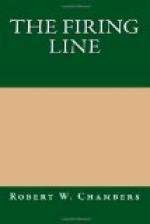“Sommus-Kala-ne-sha-ma-lin,” said the Indian quietly; and the girl interpreted: “He says, ‘Good wishes to the white man.’”
Hamil dismounted, turned and lifted Shiela from her saddle, then walked straight to the Seminole and offered his hand. The Indian grasped it in silence.
“I wish well to Little Tiger, a Seminole and a brave hunter,” said Hamil pleasantly.
The red hand and the white hand tightened and fell apart.
A moment later Gray came galloping up with Eudo Stent.
“How are you, Coacochee!” he called out; “glad to see you again! We saw the pine tops blue a mile back.”
To which the Seminole replied with composure in terse English. But for Mr. Cardross, when he arrived, there was a shade less reserve in the Indian’s greeting, and there was no mistaking the friendship between them.
“Why did you speak to him in his own tongue?” asked Hamil of Shiela as they strolled together toward the palmetto-thatched, open-face camp fronting on Ruffle Lake.
“He takes it as a compliment,” she said. “Besides he taught me.”
“It’s a pretty courtesy,” said Hamil, “but you always do everything more graciously than anybody else in the world.”
“I am afraid you are biassed.”
“Can any man who knows you remain non-partisan?—even your red Seminole yonder?”
“I am proud of that conquest,” she said gaily. “Do you know anything about the Seminoles? No? Well, then, let me inform you that a Seminole rarely speaks to a white man except when trading at the posts. They are a very proud people; they consider themselves still unconquered, still in a state of rebellion against the United States.”
“What!” exclaimed Hamil, astonished.
“Yes, indeed. All these years of peace they consider only as an armed truce. They are proud, reticent, sensitive, suspicious people; and there are few cases on record where any such thing as friendship has existed between a Seminole and a white man. This is a genuine case; Coacochee is really devoted to dad.”
The guides and the wagon had now arrived; camp was already in the confusion and bustle of unloading equipage and supplies; picket lines were established, water-jars buried, blankets spread, guns, ammunition, rods, and saddles ranged in their proper places.
Carter unsheathed his heavy cane-knife and cut palmetto fans for rethatching where required; Eudo Stent looked after the horses; Bulow’s axe rang among the fragrant red cedars; the Indian squatted gravely before a characteristic Seminole fire built of logs, radiating like the spokes of a cart-wheel from the centre which was a hub of glowing coals. And whenever it was necessary he simply shoved the burning log-ends toward the centre where kettles were already boiling and sweet potatoes lay amid the white ashes, and a dozen wild ducks, split and skewered and basted with pork, were exhaling a matchless fragrance.




